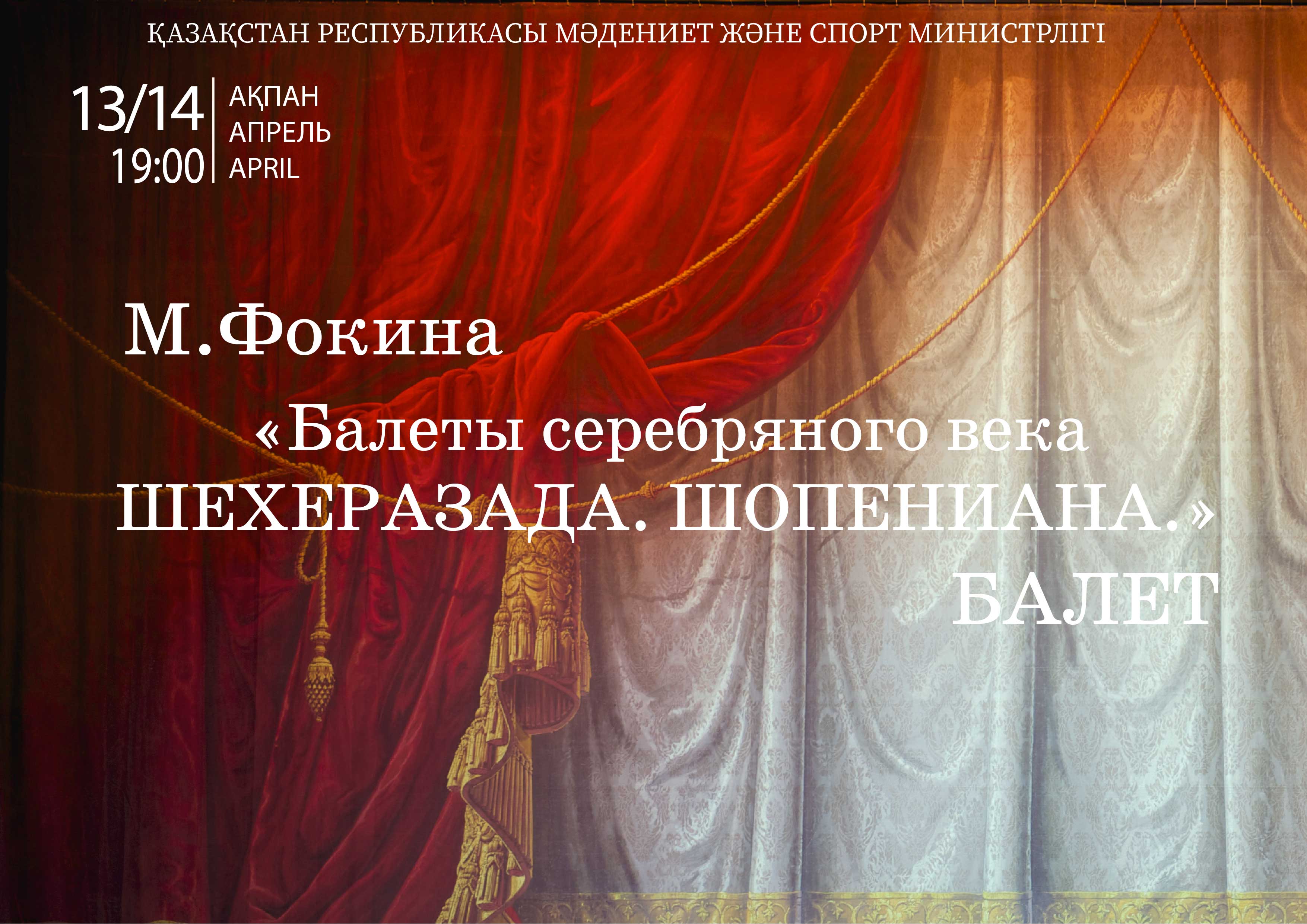Scheherazade to the music of Nikolai Rimsky-Korsakov Chopiniana to the music of Frédéric Chopin from the cycle The Silver Age Ballets
2020 / 2021 Main Hall the 8th Season
13-14 April * Tuesday / Wednesday * 7.00 pm
Dear guests!
We remind you that people over 65 years old are temporarily restricted to visit the theatre.
(In accordance with the Decree “On restrictive and quarantine measures in the city of Nur-Sultan” dated 02.02.2021 No. 5, clause 1.5. signed by the Chief State Sanitary Doctor Beisenova S.S.)
We also ask you to maintain social distancing and wear masks during the interval.
Mikhail Fokine’s Ballets
Chopiniana to the music of Frédéric Chopin,
Scheherazade to the music of Nikolai Rimsky-Korsakov
from the cycle The Silver Age Ballets

Mikhail Fokine’s Ballets
Chopiniana to the music of Frédéric Chopin,
Scheherazade to the music of Nikolai Rimsky-Korsakov
from the cycle The Silver Age Ballets
At the turn of the 19th and 20th centuries, the talented choreographer Mikhail Fokine was a person who expressed new trends and new ideas in the Russian ballet. He greatly contributed to the Russian ballet art, expanded the circle of ideas and images, and enriched it with new forms and styles.
Chopiniana
(one-act ballet to the music of Frédéric Chopin)
Choreography by Mikhail Fokine
Revised version by Agrippina Vaganova (1931)
Set and costume design based on original sketches by Alexandre Benois and Orest Allegri
Ballet Master – Producer: Altynai Asylmuratova, People’s Artist of Russia
Conductor: Arman Urazgaliyev
Assistant Ballet Masters – Producers: Konstantin Zaklinsky, Honoured Artist of Russia / Elena Sherstneva
Set Design: Victor Carare
Costume Designer: Arassel Dosmuratova
Lighting Designer: Vincenzo Raponi
In 1908, Mikhail Fokine composed a non-narrative ballet sketch. As the choreographer wrote, it was “in the style of that long-forgotten time, when ballet was governed by poetry, when a dancer rose en pointe not to demonstrate the steel-like arch of her foot, but in order to create the impression of lightness, barely touching the ground, something ethereal and fantastical… I have tried not to surprise people with the novelty, but rather to restore the conventional ballet dancing to the point of its greatest advances. I don’t know how our ballet predecessors danced. And no one else knows that. But in my dreams this is precisely how they did dance.”
The entire suite, woven by the choreographer of fleeting visions consonant with Chopin’s music, captivate the audience by its pensive beauty.
LEAD ROLES AND PERFORMERS
Young Man: Yerkin RAKHMATULLAYEV, Honoured Worker of Kazakhstan /
Zhananur ZHANABEKOV
Seventh Waltz: Aigerim BEKETAYEVA, Honoured Worker of Kazakhstan /
Shugyla ADEPKHAN
Eleventh Waltz: Moldir SHAKIMOVA /
Adelina TULEPOVA
Prelude: Mariko KITAMURA /
Anastasia ZAKLISKAYA
* * * * * * *
Scheherazade
(one-act choreographic drama to the music of Nikolai Rimsky-Korsakov)
Scenario by Mikhail Fokine after the Arabian Nights fairytales
Choreography by Mikhail Fokine (1910). Reconstruction by Andris Liepa
Sets and costumes after original sketches by Léon Bakst
Choreographer Andris Liepa, People’s Artist of Russia
Assistant Choreographer Svetlana Romanova
Conductor Arman Urazgaliyev
Set Designer Anatoly Nezhny
Costume Designer Elena Netsvetaeva-Dolgaleva
Lighting Designer Vitaly Davydkin
Artistic Director of the Astana Opera Ballet Company – Altynai Asylmuratova, People’s Artist of Russia
The bored Sultan Shahryar is being entertained by odalisques and his beloved wife Zobeide. The Sultan’s younger brother Shakhezman is also here, he lost faith in women after his beloved wife betrayed him. He does not believe his brother’s wives either and offers his brother to test their loyalty. Both Sultans go hunting, while their wives touchingly bid farewell to them. Almost as soon as the Sultans are gone, the wives bribe the Chief Eunuch who opens the door of the harem. Black slaves burst in, and shameless depravity begins. Zobeide reigns here, having fun with her beloved Slave. In the midst of such “merrymaking”, the brothers return. Shakhezman triumphs, Shahryar is enraged and orders to execute everyone on the spot. Sultan’s servants kill the odalisques, eunuchs and black slaves. Sultana Zobeide, whom her spouse Shahryar believed more than himself, relies on her power over him and tries to appease him. The Sultan is unable to give the order to execute her. However, his cunning brother contemptuously points at Zobeide’s hacked to death lover. Shahryar gives a sign to the executioners, but his wife manages to grab a dagger from him and takes her own life. Shahryar cries over the dead body of his unfaithful, but beloved woman.
LEAD ROLES AND PERFORMERS
Shahryar: Zhanibek IMANKULOV /
Rakhmetulla NAUANOV
Shakhezman: Ildar SHAKIRZYANOV /
Yerlan ZHAMBULAYEV
Zobeide: Anastasia ZAKLINSKAYA /
Anel RUSTEMOVA, Honoured Worker of Kazakhstan
The Golden Slave: Bakhtiyar ADAMZHAN, Honoured Worker of Kazakhstan /
Serik NAKYSPEKOV
Chief Eunuch: Olzhas MAKHANBETALIYEV /
Zhanadil BEISSEMBIYEV
BALLET DANCERS, SYMPHONY ORCHESTRA OF THE ASTANA OPERA HOUSE
Running time: 1 hour 55 minutes, including one interval
Share with Friends
You may also be interested in the following events:
 20 000 лье под водой: Капитан ...
20 000 лье под водой: Капитан ...
 Багровый рассвет (2024)
Багровый рассвет (2024)
 Формула 1 (2025)
Формула 1 (2025)

